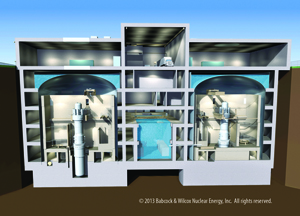Big Problems, Small(er) Answers
Christofer Mowry ’84 embraces quest for safe nuclear technology

Christofer Mowry ’84 (right) surveys the spacer grids that go into a small, modular reactor. These grids hold nuclear fuel pellets. Left: Todd Lee of Babcock & Wilcox; center: Peter Lyons of the U.S. Department of Energy.
In 1979, a meltdown at the Three Mile Island nuclear power plant near Harrisburg, Pa., turned “nuke” into a four-letter word and forever changed the nuclear energy industry in the United States. From the day of the accident until 2012, not a single new full-sized nuclear power plant started construction (although quite a few plants already under construction were completed).
However, for Christofer Mowry ’84, the notorious accident had exactly the opposite effect: it set him on the path to becoming a nuclear engineer. “I was in junior high when that happened, and that’s when I became aware of nuclear power,” he says.
Mowry has dedicated his career to the energy industry and most of it to nuclear power. He is currently the CEO of Generation mPower LLC, a company that designs and sells a new kind of nuclear plant small enough to build off-site and deliver by truck, rail, or barge. This year, mPower reached an agreement with the Tennessee Valley Authority to install the first two of these “small modular reactors” at Clinch River, near Oak Ridge, Tenn.
Mowry’s years at Swarthmore had a lot to do with his career choice. He applied for and received a scholarship from the Institute of Nuclear Power Operations (INPO), an industry organization formed after Three Mile Island to “promote excellence in the operation of commercial nuclear power plants.” He started getting serious about nuclear energy between his junior and senior years when Professor of Engineering Nelson Macken sponsored him to work on nuclear plant safety at Siemens Research Center in Erlangen, Germany. After he graduated, Mowry got his first job working for Philadelphia Electric Co., which was constructing the Limerick nuclear plant near Pottstown, Pa.
“Why would someone from Swarthmore go into the nuclear business? One of the things that you learn at Swarthmore is not to just accept established paradigms,” Mowry says. “You learn to question the accepted wisdom and to be intellectually honest.” That led him to conclude that instead of running from nuclear energy, we should learn how to make it safe.
Mowry’s subsequent jobs exposed him to many sides of the energy business. At Philadelphia Electric Co. he eventually became a senior reactor operator. In 1993, he left to work for INPO, which enabled him to see the inner workings of many nuclear plants. Subsequently he worked for General Electric (the company that designed Limerick), traveling to Sweden to work on nuclear projects and to Norway to work on hydroelectric projects. Then, for a while, he ran a company that did robotic welding for both the nuclear and non-nuclear sectors of the energy industry. In 2008, Babcock & Wilcox, a longtime leader in nuclear energy, hired him as its chief development officer. He quickly became interested in the small modular reactor project, which was spun off into a separate company, Generation mPower.

A diagram of the containment structure of a small modular reactor. The reactor is entirely underground, which makes it easier to defend from terrorist attacks.
As Mowry explains it, the mPower reactor descends from a “small integral reactor” built in the 1960s for a German ship called the Otto Hahn. One of four commercial ships powered by a nuclear generator, it logged 650,000 nautical miles before its conversion to diesel. Though nuclear-powered ships never became commercially viable, Mowry says, “That [small integral reactor] idea has percolated for decades, been updated and advanced, made more efficient and safer, and has now emerged as the basic mPower design.” He expects the Clinch River reactors to start generating electricity by 2021, and he says that the concept has attracted “lots of interest from other countries, including China.”
Mowry’s ties to Swarthmore have remained strong. He married math major Christina Rossetti ’86 and has three children, including Annelise ’12.
After a career in the energy business, Mowry still believes that “intellectual honesty” is the best argument for nuclear power. “Climate change and the recognition of the impact of carbon emissions are forcing companies and societies to look at energy in a different way,” Mowry says. “Among the renewables, there are practical limits to how much an intermittent source, like wind, can contribute to the entire energy mix. If you’re intellectually honest and you look at the technologies available together with the needs of society, you have to embrace responsible deployment of nuclear technology.”
 Email This Page
Email This Page